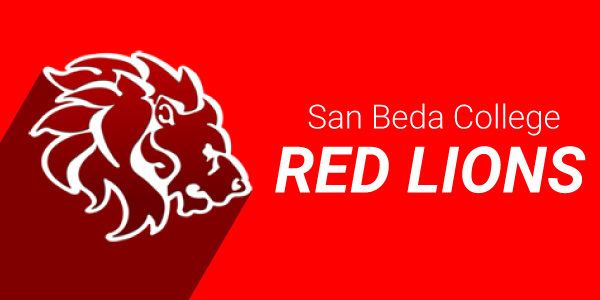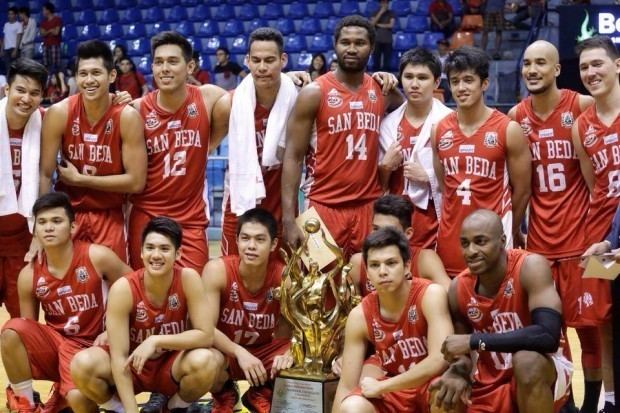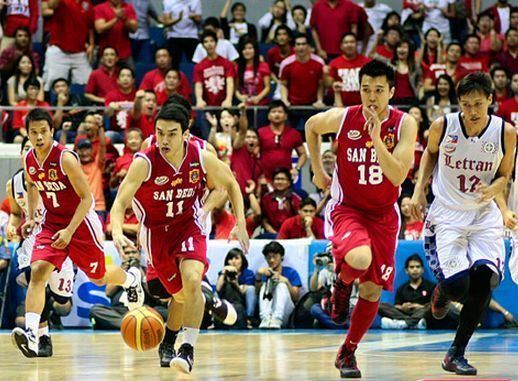Fight song Indian Yell Color Red and White | Joined 1924–83, 1986–present Women's team Red Lionesses | |
 | ||
Team colors Red and White | ||
Ncaa season 91 preview san beda red lions
The San Beda Red Lions is the collegiate varsity basketball team of San Beda College that plays in the NCAA. The juniors basketball team is called the Red Cubs of San Beda College-Rizal, while the women's varsity basketball team is called the Red Lionesses. The latter plays in the Women's National Collegiate Athletic Association.
Contents
- Ncaa season 91 preview san beda red lions
- Ncaa seniors basketball champions san beda red lions
- Team red monickers
- Name
- Animo San Beda
- Red Lion and The Ancient Red Lion Rampant
- Indian Yell
- Little Indians
- End 28 82
- ANIMo San Beda
- The San Beda Red Army
- Football
- NCAA Season 91 Junior Boys Volleyball Roster
- NCAA Season 91 Mens Volleyball Roster
- NCAA Season 91 Womens Volleyball Roster
- NCAA Season 91 Beach Volleyball Roster
- Notable players
- WNCAA
- Soft tennis
- References

San Beda is the only founding member of the NCAA left in the league.
Ncaa seniors basketball champions san beda red lions
Team red monickers

The Lion is the mascot of all the varsity teams, but only the men's varsity basketball team is called the Red Lions. The other varsity teams have their own names for distinction purposes. Here are the official names of the San Beda varsity teams:
* Not competing in the NCAA
Name

San Beda is named after the Venerable Bede of England. In honor of Venerable Bede who is an English man, the school chose the Red Lion Rampant which is the heraldic symbol of the ancient Scots/English for courage as part of its school logo. San Beda pays tribute to the courage of the Benedictine monks by adopting the Red Lion, the symbol of courage in the Catholic tradition and in the land of St. Bede.
"¡Animo San Beda!"
One of the more popular line in the traditional Bedan cheers is "¡Ánimo San Beda!".

Bedans use ¡Ánimo! to mean COURAGE in their cheers. When Bedans yell "¡Ánimo San Beda!" they actually mean "Courage San Beda!/Have Courage San Beda!", faithful to the Spanish idiomatic usage of the word. ¡Ánimo! is a Spanish word which means spirit, energy, vitality, purpose and will. Used as an expression of encouragement by Spanish speaking societies, it means courage or have courage. "Avance San Beda!" and "Vamos!" were also popular then. In the pre-war Spanish San Beda cheer (also known as El Colegio de San Beda Tiene que Ganar!), "¡Ánimo!" is also included. Even in the traditional English cheer, "Stand on the Grandstand", "¡Ánimo!" is extensively used. It is a shared belief among Bedans that the popular line "Animo ________, Beat _________" used by other schools as a stand-alone cheer, originated from the 1950s Bedan Cheer Stand on the Grandstand".
The most recent cheer which incorporates "¡Ánimo San Beda!" is the 1970s SBCA. Said cheer was adopted in the 1970s to pay tribute to the new addition to the Benedictine community, the Benedictine Abbey School – San Beda Alabang.
Red Lion and The Ancient Red Lion Rampant
American Catholic schools started the practice of adopting a school mascot when they became wary of sports headlines such as "St. Peter mauls St. Paul 80 – 40". School administrators and the local Catholic parishioners became uncomfortable with a saint whipping another saint. In the Philippines, schools started to copy this practice in the early 1940s.

On July 31, 1940, Fr. Sergio Martinez OSB, inspired by English tradition, coined the moniker "Red Lion" for the school. Red is the color of courage, of a warrior and a martyr. The lion on the other hand represents dominance, the King of the Jungle.

In the old heraldic tradition, combining RED with the LION symbolizes dauntless courage, bravery, strength, ferocity, valor and magnanimity in victory. In its ancient and traditional form, San Beda's Red Lion is actually the Red Lion Rampant of Scotland which eventually became a prominent English heraldic symbol.

In the Catholic tradition, the Lion is the accompanying symbol of courage whose symbolism itself is rooted in the ancient Lion of Judah. The Roman family of St. Benedict himself used the Lion Rampant as their coat of arms.
It is not by mere coincidence that the school adopted the Red Lion/Red Lion Rampant of Scotland as the school symbol. San Beda College was named after a great Benedictine Saint whose country of origin, England, has adopted for its own the heraldic symbol of the Scots, the Red Lion Rampant. In addition, it is a historical fact that the history of England in general and of its church in particular, is deeply connected with the history of the Benedictines in that country. St. Bede was one of England’s greatest contribution to the world. The Red Lion of Scotland on the other hand became a popular and quintessential symbol in England with the Union of the Crowns. Thus the Red Lion, rooted in the traditional Red Lion Rampant of Scotland and the ancient Lion of Judah, is a fitting symbol for the Catholic Benedictine School named after the Venerable Bede of England.
Indian Yell
The Cuerba brothers, both Bedans, composed the Indian Yell in 1947 after the liberation from the Japanese occupation. The Indian Yell was initially solely performed on drums accompanied by cheers from the students. However, this made the cheer somewhat lacking in power and needed something to rejuvenate the audience. So they changed the sound of the yell and incorporated a horn section. Accompanied by the tomahawk chop, the Indian Yell became more lively, intimidating, and full of spirit.
The Indian Yell is San Beda's romanticized version of the Indian war whoop. It mimics the native Indian war chants and vocalization techniques designed to intimidate the opponent. North American Indian war chants are verbalization of tunes that implore the great spirits to help them in battle. The romanticized Bedan Indian Yell is believed to have been inspired by the Plains Indian.
The Indian war whoop also gave rise to various derivative chants, most especially the Lion's Roar. The Lion’s roar, with the simple "Wooohooo", also mimics primitive chants of Native American Indians. This is an indirect offspring of the Wahoos started by both Dartmouth College and the University of Virginia in the 1890s. Bedans popularized this aboriginal Native American form of chanting in the Philippine collegiate league and has spawned variations now used by many other schools.
The Native Americans were a courageous and defiant people. This is also true with the ancient Scottish warriors and their Red Lion Rampant. From the Old World (Europe), Bedans adopted the Red Lion while from the New World (North America) they adopted the Native Americans. Both are Red and both are symbols of Courage.
The ingredients were actually ripe for an Indian inspired theme to gain popularity and acceptance among Bedans. The Scouting movement, introduced to the country by the Americans, became very popular in San Beda College. Worldwide, the movement and the infatuation with North American Indian cultures grew hand in hand. According to Philip J. Deloria in Playing Indian, Indians became a major "lure" to recruit boys. In fact, North American Indian iconography is not only popular in the Scouting movement but in many aspects of the Euro-American psyche. Combining this infatuation, reinforced by the popularity of North American iconography in the movies, literature and American sports, led to the blossoming of an Indian inspired theme in San Beda.
Little Indians
To accompany the Indian Yell, the Little Indians were conceptualized by Ramon Ventoza (. GS '46, HS '51). Mon Ventoza is the longest serving moderator / instructor of the San Beda College Cheering Association. A cheerleader himself during his student days in San Beda College, Mon was appointed as instructor of the College's Cheering Squad (1952–1962). He came up with idea to accompany the Indian Yell for the half time cheering.
There were only three Indians in 1947: Gabriel Gasar and the Casal brothers, one of which eventually became a Benedictine monk. Slowly, the recruitment process changed and participation from the grade school pupils rose because many wanted to become Little Indians. Tito Mon wanted the Indians to be stout and adorable. From three Indians since 1947, the membership rose to a minimum of eight in the 90’s.
End 28 @ 82
"End 28 @ 82", was the battlecry the San Beda Red Lions used in reference to their quest to conclude the 28 years of seniors basketball championship title drought. The battlecry was a "grassroots" call to arms that was started in Bedista.com by Bedans. The slogan slowly gained popularity among Bedans and was eventually embraced by the entire community.
The last time the Red Lions won the championship was against the De La Salle Green Archers in 1978 and earlier against the Ateneo Blue Eagles in 1977 on the strength of a team bannered by Chito Loyzaga, Frankie Lim, and Jayvee Yango. On September 22, 2006, they finally managed to get another Championship Trophy after winning the Best-of-Three series against the Philippine Christian University Dolphins. On the way to the championship, the Red Lions displayed its dominant form. After losing its second game against the PCU Dolphins, San Beda went on a 12-game winning streak to finish the eliminations on top of the standing with a 13–1 win/loss card. During their Final Four game against the MIT Cardinals, they managed to come back from a double digit deficit to seal their seat in the Finals. In the championship series, they handily won their first game against PCU before succumbing to pressure and very poor shooting in a blowout loss in game 2. The Red Lions finally showed poise in the winner take all rubber match and won a scintillating one point victory to reclaim the championship trophy that has eluded them the past 28 years.
ANIMo San Beda
The battlecry "ANIMo San Beda" is used in reference to their quest to achieve the first six-peat in NCAA Seniors' Basketball history. It was first popularized by a group of students/die-hard fans from San Beda College Alabang. Not much is known about its origin. However this yell has gained popularity on social media sites like Facebook.
The San Beda Red Army
The Bedan Red Army refers to all Chiefs, the Tribe, Republika Bedista or any Bedan diehard/hardcore warriors of the stands. The heckle and yell team. We are all San Beda's Red Army.
Football
Dubbed the "Red Booters", the San Beda football team has been a consistent championship contender for the past few years in the NCAA. The seniors team has won the NCAA championship for the last 6 years and has won a total of 14 championships, second only to De La Salle University in all-time wins.
NCAA Season 91 Junior Boys' Volleyball Roster
Coach: Nemesio Gavino
NCAA Season 91 Men's Volleyball Roster
Coach: Jose Roque
NCAA Season 91 Women's Volleyball Roster
Source:
Coach: Nemesio Gavino
Assistant Coach: Aiza Maizo-Pontillas/Chie Saet
NCAA Season 91 Beach Volleyball Roster
Women's
Men's
Juniors
Notable players
WNCAA
The San Beda Alabang girls' volleyball team won the 39th WNCAA championship title. They are the first juniors team to bring a volleyball championship title to their alma mater.
Soft tennis
The San Beda's women's soft tennis team, headed by team captain Alyana Victoria and head coach Jovy Mamawal, won two consecutive titles in the NCAA soft tennis event in Seasons 90 and 91. Aside from their championships, The Red Lionesses represented the country in the University Soft Tennis Championships in 2015 held at South Korea.
